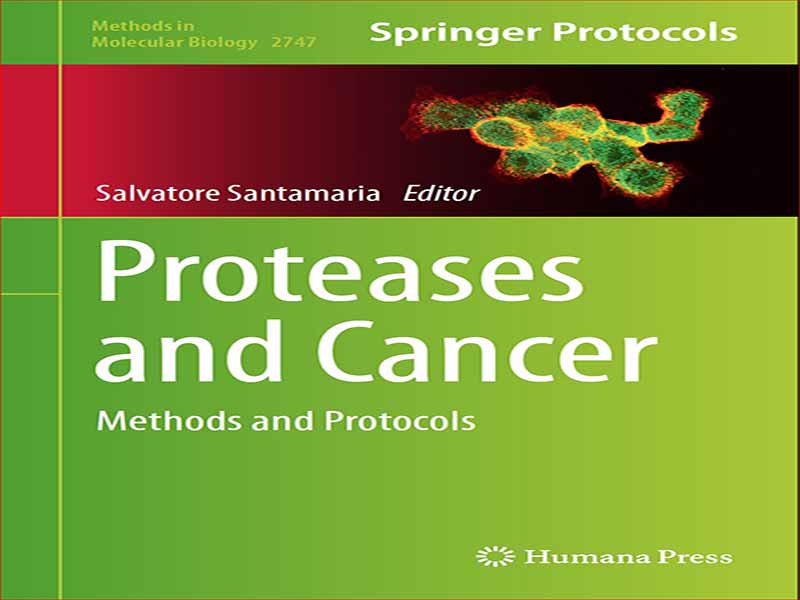- عنوان کتاب: Proteases and Cancerols
- نویسنده: Salvatore Santamaria
- حوزه: سرطان
- سال انتشار: 2024
- تعداد صفحه: 201
- زبان اصلی: انگلیسی
- نوع فایل: pdf
- حجم فایل: 10.5 مگابایت
پروتئازها بازیگران اصلی در فرآیندهای متعدد مرتبط با انکوژنز مانند تهاجم و تکثیر سلولی، نئوآنژیوژنز، ریزش و تحرک فاکتورهای رشد و سیتوکین ها هستند. اگرچه در حال حاضر این جنبه مضر و تاریک فعالیت پروتئولیتیک در مرکز علمی Weltanschauung قرار دارد، پروتئازها همچنین می توانند نقش های تعدیل کننده ایمنی، خوش خیم و سرکوب کننده تومور را ایفا کنند.
این جلد از مجموعه روشها در زیستشناسی مولکولی شامل 22 فصل است که طیف گستردهای از موضوعات و تکنیکها از جمله تجزیه و تحلیل بیوانفورماتیک، سنجشهای بیوشیمیایی، بیان و خالصسازی پروتئین نوترکیب، روشهای بررسی فعالیت پروتئاز در سیستمهای مبتنی بر سلول، ارگانوئیدها و in vivo را پوشش میدهد. پروتئومیکس، رونویسی، یادگیری ماشینی، و رویکردهای جدید برای هدف قرار دادن فعالیت پروتئاز نامنظم در سرطان. هدف اصلی من ارائه مجموعه ای متنوع و معرف از روش های پیشرفته به جامعه علمی برای بررسی عملکردهای پروتئینی پروتئازها (بدون جناس) در زیست شناسی سرطان بود. این جلد برای مخاطبان وسیعی از پژوهشگران پایه و بالینی در زمینهها و رشتههای مختلف (شیمیدانان، بیوشیمیدانان، زیستشناسان سلولی و مولکولی، بیوان-فورماتیکها و پزشکان) طراحی شده است و محتوای آن برای پژوهشگران در هر مرحله از کارشان مناسب است. مشاغل
فصل 1 خواننده را با دنیای پروتئازهای سرطانی با ارائه فهرستی از پایگاه های دانش مبتنی بر وب و پورتال های مفید برای استخراج داده ها در مورد عملکرد پروتئاز آشنا می کند. فصل 2 روشهای پروتئومیکس/N-terminomics برای توصیف و تعیین کمیت پایانههای طبیعی و neo-N پروتئینها از نمونههای پیچیده بیولوژیکی با هدف نهایی شناسایی سوبستراهای پروتئاز کاندید را توضیح میدهد. تشخیص فعالیت پروتئاز در نمونههای بیولوژیکی کاربردهای گستردهای در سرطان دارد، اما این امر بهویژه در مورد متالوپروتیزها که فاقد یک واسطه کووالانسی در طول واکنش پروتئولیتیک هستند، چالش برانگیز بوده است. فصل 3 روشی را برای نظارت و تعیین کمیت فعالیت متالوپروتئیناز ماتریکس با استفاده از یک پروب مبتنی بر میل توصیف می کند. فصلهای 4-6 بر روشهایی برای بیان و خالصسازی پروتئازهای نوترکیب، یک گام اساسی برای توصیف عملکرد پروتئاز، تمرکز دارند. فصل 4 توضیح می دهد که چگونه N-گلیکان ها را در پروتئازهای نوترکیب معرفی کنیم تا بقایای موجود در برهمکنش پروتئین-پروتئین را نقشه برداری کنیم، در حالی که Chaps. 5 و 6 بیان نوترکیب و خالص سازی دو پروتئاز را به ترتیب با نقش ضد سرطانی و پیش سرطانی توصیف می کنند. فصلهای 7-9 تعدادی از سنجشها را برای تجزیه و تحلیل فعالیت پروتئولیتیک در شرایط آزمایشگاهی توصیف میکنند. فصل 7 یک روش مبتنی بر الایزا را برای ترسیم مکان های اتصال کلاژناز روی کلاژن ها شرح می دهد. روش دیگر مبتنی بر الایزا برای تعیین کمیت برش پروتئوگلیکان ورسیکان توسط پروتئازهای ADAMTS در فصل گزارش شده است. 8، در حالی که فصل. 9 نحوه تجزیه و تحلیل قطعات برش پروتئین ماتریکس خارج سلولی استئوپونتین تولید شده توسط ترومبین سرین پروتئاز را توضیح می دهد. فصل 10 چگونگی تجزیه و تحلیل فعالیت شیداز ADAM17 را با ناک داون با واسطه siRNA در مونوسیت های اولیه انسان جدا شده از خون محیطی شرح می دهد. فصلهای 11-16 همگی روشهایی را برای بررسی تکثیر سلولهای سرطانی، مهاجرت، تهاجم و تخریب ماتریکس خارج سلولی توضیح میدهند. فصل 11 آماده سازی ماتریس هایی را توضیح می دهد که ریزمحیط تومور را تقلید می کنند. سفتی ارائه شده توسط این ماتریس ها الگوهای خاصی از بیان پروتئاز را در رده های سلولی مهاجم ایجاد می کند. فصل 12 روشهایی را برای مطالعه اینوادوپودیا، برآمدگیهایی که در لبه پیشروی سلولها تشکیل میشوند و تخریب پروتئولیتیک ماتریکس خارج سلولی را واسطه میکنند، توضیح میدهد. تعدادی از روشها برای بررسی عملکرد MT1-MMP، محرک اصلی تهاجم سلولی، در فصل گزارش شدهاند. 13. یک پروتکل زیموگرافی اصلاح شده برای مطالعه فعالیت ژلاتیناز در سلول های سرطانی روده بزرگ در فصل توضیح داده شده است. . فصلها و گسترش این پروتکلها از فرهنگهای دو بعدی به سه بعدی، در حالی که فصل. 17 یک روش تصویربرداری in vivo را توصیف می کند که ترکیبی از میکروسکوپ کانفوکال و دو فوتون برای تجزیه و تحلیل فعالیت پروتئولیتیک و آزمایش اثر مهارکننده های پروتئاز بر مهاجرت سلول های لوسمی میلوئید حاد است. بخش پایانی. تمرکز بر رویکردهایی برای مهار فعالیت پروتئولیتیک در سرطان. فصل 18 نحوه تنظیم یک سنجش FRET برای غربالگری با توان بالای مهارکنندههای MT1-MMP را توضیح میدهد. استفاده از کتابخانه های ترکیبی برای جداسازی مهارکننده های انتخابی پروتئاز در فصل گزارش شده است. و به ترتیب بر روی آنتی بادی های مونوکلونال و مهارکننده های بافتی انواع متالوپروتئیناز تمرکز دارند. فصل تولید انواع ماکروگلوبولین آلفا-2، یک مهارکننده پروتئاز با طیف وسیعی است که به وفور در پلاسما وجود دارد، برای هدف قرار دادن پروتئازهای خاص. فصل آخر ترکیبی از طیفسنجی جرمی، هوش مصنوعی و روشهای محاسباتی را برای کشف و توصیف پپتیدهای بازدارنده پروتئاز از منابع طبیعی گزارش میکند.
Proteases are major players in multiple processes related to oncogenesis such as cell invasion and proliferation, neoangiogenesis, shedding, and mobilization of growth factors and cytokines. Although at the present this detrimental, dark side of proteolytic activity takes center stage in the scientific Weltanschauung, proteases can also exert immunomodulatory, benign and tumor-suppressive roles.
This volume of the Methods in Molecular Biology series consists of 22 chapters covering a wide range of topics and techniques including bioinformatics analysis, biochemical assays, recombinant protein expression and purification, methods to investigate protease activity in cell-based, organoids and in vivo systems, proteomics, transcriptomics, machine learning, and novel approaches to target dysregulated protease activity in cancer. My chief aim was to provide the scientific community with a diverse and representative collection of state-of-the-art methods to investigate the protean functions of proteases (no pun intended) in cancer biology. The volume is designed for a broad audience of basic and clinical researchers across different fields and disciplines (chemists, biochemists, cell and molecular biologists, bioin-formaticians, and physicians) and its content was intended to be suitable for researchers at every stage of their careers.
Chapter 1 introduces the reader to the world of cancer proteases by presenting a list of web-based knowledgebases and portals useful to mine data on protease function. Chapter 2 describes proteomics/N-terminomics methods to characterize and quantify the natural and neo-N-termini of proteins from complex biological samples with the final aim to identify candidate protease substrates. Detecting protease activity in biological samples has wide applications in cancer, but this has been particularly challenging in the case of metallopro-teases, which lack a covalent intermediate during the proteolytic reaction. Chapter 3 describes a method to monitor and quantify matrix metalloproteinase activity using an affinity-based probe. Chapters 4–6 focus on methods for expressing and purifying recombi-nant proteases, an essential step to characterize protease function. Chapter 4 explains how to introduce N-glycans in recombinant proteases to map residues involved in protein-protein interactions, while Chaps. 5 and 6 describe recombinant expression and purification of two proteases with anti-and pro-cancerogenic roles, respectively. Chapters 7–9 describe a number of assays to analyze proteolytic activity in vitro. Chapter 7 describes an ELISA-based method to map collagenase binding sites on collagens. Another ELISA-based method to quantify cleavage of the proteoglycan versican by ADAMTS proteases is reported in Chap. 8, while Chap. 9 explains how to analyze cleavage fragments of the extracellular matrix protein osteopontin generated by the serine protease thrombin. Chapter 10 describes how to analyze the sheddase activity of ADAM17 by siRNA-mediated knockdown in primary human monocytes isolated from peripheral blood. Chapters 11–16 all describe methods to investigate cancer cell proliferation, migration, invasion, and extracellular matrix degradation. Chapter 11 describes the preparation of matrices that mimic the tumor microenvironment. The stiffness presented by these matrices elicits specific patterns of protease expression in the invading cell lines. Chapter 12 describes methods to study the invadopodia, protrusions that form on the advancing edge of cells and that mediate proteo-lytic degradation of the extracellular matrix. A number of methods to investigate the function of MT1-MMP, a major driver of cell invasion, are reported in Chap. 13. A modified zymography protocol to study gelatinase activity in colon cancer cells is described in Chap. . Chapters and extend these protocols from 2D to 3D cultures, while Chap. 17 describes an in vivo imaging method combining confocal and two-photon microscopy to analyze proteolytic activity and testing the effect of protease inhibitors on acute myeloid leukemia cell migration. The final Chaps. , focus on approaches to inhibit proteolytic activity in cancer. Chapter 18 explains how to set up a FRET assay for high-throughput screening of MT1-MMP inhibitors. The use of combinatorial libraries to isolate selective protease inhibitors is reported in Chaps. and , which focus on monoclonal antibodies and tissue inhibitor of metalloproteinase variants, respectively. Chapter describes the generation of variants of alpha-2 macroglobulin, a broad-spectrum protease inhibitor abundantly present in plasma, to target specific proteases. The final Chapter reports a combination of mass spectrometry, artificial intelligence, and compu-tational methods to discover and characterize protease inhibitory peptides from natural sources.
این کتاب را میتوانید بصورت رایگان از لینک زیر دانلود نمایید.
Download: Proteases and Cancerols




































نظرات کاربران